Bradstone's 2007 Catalogue
Better late than never, the 2007 Bradstone catalogue arrives at Borlochs Hall courtesy of marketing manager Paul Wagstaff, and it comes as no great surprise to see that the front cover has been given over to the superb "Old Town Chelsea Cobble" that was my runner-up best new product at Glee last year. The angle of the photo could be slightly misleading, as the 'cobble-thing' nearest the camera looks as though it could easily be 450mm or so in diameter, when, in actuality, it's less than half that. Still, it looks bally good!
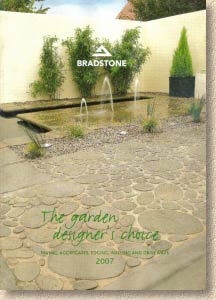
The other noticeable feature if the front cover is the text: “The garden designer's choice”, apparently. Mmmm: that could be a bit limiting, I feel. Admittedly, Bradstone built its reputation as a wet-cast manufacturer of high quality garden paving, but I was under the impression that all the musical chairs and re-filing that had taken place within Aggregate Industries over the past 18 months or so was intended to sharpen Bradstone's focus as a supplier of Residential paving, patios and driveways, and not just “garden paving”. Why else reinforce the concept of a separate identity from (block manufacturer) Charcon? Looking at the comprehensive index, a measly sixteen pages out of a total of one hundred and sixteen have been dedicated to 'driveways', so is the commitment to block paving being diluted?
Or maybe it's that the 'garden' aspect is being over-emphasised. The inside cover describes the somewhat arbitrary sub-division of the Bradstone range into four “Garden Styles, namely 'Classic', 'Mediterranean', 'Contemporary' and 'Designer'. Phew! I'm not sure how much difference there is between “Contemporary” and “Designer”, and there doesn't seem to be a category for my garden (semi-rural, family, low-maintenance, must cope with kids, bikes, and drunken adults on the warmer summer evenings), but maybe I'm in a minority. Perhaps in Britain of 3007, I'm entitled to be a minority – it seems every other bugger I meet is a minority, so I want to be one, too!
The Garden message is further reinforced with the display of a handful of RHS shiny medals and then a whole page bigging-up the Gold Medal winning Chelsea garden created with the invaluable assistance of Bradstone products and Agg Inds deep pockets way back last spring. The Old Town Chelsea Cobble (OTCCs) are there again, and on the next page, which is ostensibly concerned with The Wildlife Trust, but hey! If you've an ace in your hand, you might as well make sure everyone is aware of it!
Flicking through the garden style pages, pausing only to admire the quality of the photos and muse for a few seconds more on the vagaries of the garden definitions, the first chunk of genuine information is found on page 16, and the Old Town range of high quality riven reproductions leads the way. I can't spot it in this section, but one of the pages uses the truly awful euphemism “reformed stone”. As a certain Mr James Royle of Manchester might say, “reformed stone my arse!” Regardless of the material used to manufacture these flags (mere mortals such as meself will have to be excused for thinking it is concrete for the middle-classes) the Old Town range has justifiably crept to the top of the pecking order at Bradstone. Nine individual sizes plus a 6.5-ish m² “Patio Feature Pack”, with a complementary choice of circles, bull-nosed units, dished channels and not to mention the OTCCs, all means this range really could be the “garden designer's choice”. I'm not sure if it's just me, but it does seem that the full-page piccie of the Weathered Limestone flavour on page 17 looks a little washed-out, colour-wise. From that photo, it's difficult to make out the warm buff tones that are present in real-life and the whole thing looks bleached set against the garnet red filigree leaves of the Japanese Acer.
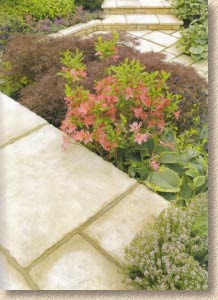
The Conservation flavour that was rather quietly released into the wild amongst last year's offerings is still available, and it's still only in the one size which does rather limit the much vaunted “designer's choice”. This is a product that needs to succeed. In a decade or so we'll all be wondering why it took us so long to realise the environmental and economic value of recycled and reclaimed aggregates for non-critical concretes. And then we'll be boring people rigid with tales about the “old days” when there was only one readily available patio flag made from regurgitated aggs! However, to make sure it does succeed, it needs to offer the punter and the designer summat more than one-size-one-colour.
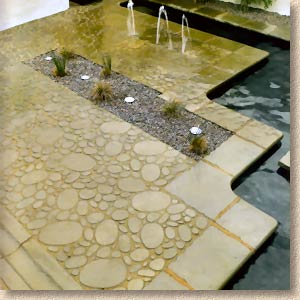
Perhaps the way forward is with the already-mentioned OTCCs, a clever twist on the carpet-stone idea of smaller units pre-arranged into interlocking patterns on a mesh-backing. This product was heavily involved in Bradstone winning a Gold Medal at RHS Chelsea last year, and won the GIMA “Best New Hard-landscaping Product” award. Like the Conservation flag above, it contains up to 85% regurgitated aggregates (not sure just what that “up to” means, exactly!), but it has the added benefit of coming in two colours – Grey-Green and Weathered Limestone. There's also side and corner units that allow it to be laid to a straight edge or abutted against other paving. For me, this is the one new product in the Bradstone range with real potential and I think the pictures say it all. It's intriguingly different, but simple-to-understand, once you are aware of the 'concept'.
As with all the other products in this vein, it's the jointing that will make-or-break it. It would be very easy to make a complete horlicks of this paving by applying a wet mortar or relying on a pathetically friable dry mix of sand and cement. To avoid any mess, and to show-off the paving to its best effect, a quality polymeric or resin-based jointing material would be my choice, but that increases the price per square metre of the completed pavement right up to, and possibly over the 'reasonable price' barrier. It will be interesting to see just what quantity, in litres or kilograms, of jointing is required per unit area.
Milldale is a wholly new product, due to be unleashed onto the unsuspecting public in March of this year. It was shown at Glee last September where it was being touted as a possible successor to the venerable “Wetherdale” range. Other than the rather tasty photos in this catalogue, the only other time I've seen this product was the teeny sample area at Glee, so I want to reserve judgment until I've had a chance to see it in natural daylight and to walk over it. The blurb claims the riven texture is subtle and shallow, which is not how I remember it. Maybe they mean subtle and shallow compared to Wetherdale!
When it does finally make it to the BMs and GCs, Milldale will be available in six individual sizes, a 6.5-ish m² Patio Pack, two sizes of circle (2.4 and 3.3m dia) plus an octagon feature, all in three distinctive colour options (Old Ivory, Golden Sands and Antique Chestnut).
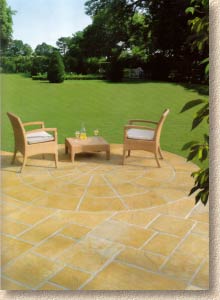
Much of the remaining catalogue features products that are familiar to most seasoned contractors and designers, and the purpose of these catalogue reviews is to highlight the new and the updated, and to consider how well the information is presented, so let's wrap up this brief look at the products by dashing through 56 pages of exquisite photos and succinct text to the only other 'newbie' for 2007, which is to be found in the Block Paving section. The Woburn range has been the Bradstone 'tumbled' block for a good few years now, and while it's an excellent product, it's never really attracted the level of interest enjoyed by some of its competitors. For me, Woburn has always been an also-ran: it's never had enough character to make it stand out from all the other tumbled blocks, and although it has a well-considered colour palette, the whole range has lacked a bit of pizzazz, a bit of summat that makes it distinctive.
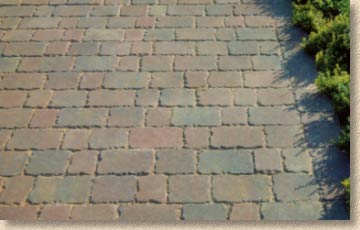
Well, I'm glad to report that, looking at the new Woburn Cobble, all that may be about to change. This new member of the family features heavily distressed arrises but with a relatively smooth and undamaged surface. This is a product that I have seen in daylight, in large-ish areas (at the Grand Opening of the EJ Stone Paving Centre last September) and it is a very distinctive looking block. The joints appear to be wider than normal, although this is just a visual effect of the distressed arrises, and the overall aesthetic is surprisingly close to that of the traditional sett-paved streetscapes of northern England, albeit with a modern twist.
Bradstone are marketing this new line at a “more economical price”, and in a range of colours that complement those of the garden flags, so there's the opportunity to use a consistent palette for both patio and driveway. The sizing remains “quirky” with its 134mm course width and the photos in the catalogue showing aligned perpendicular joints don't do it any favours, but this is a product that deserves a closer look, especially by those contractors that are not regular customers for Bradstone CBPs.
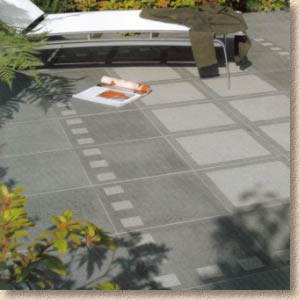
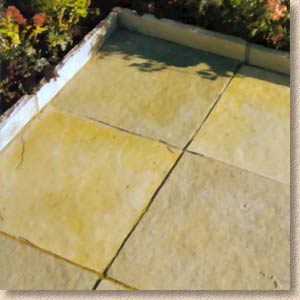
As with all of the other 'national' manufacturers, there are not a lot of new products on show, but this is largely due to a perceived need to consolidate the market position of concrete products in the face of the onslaught from imported stone. A decade ago, each successive catalogue offered a slew of new products as manufacturers jostled to be more innovative and offer a more comprehensive range than their rivals, but now those same manufacturers are relying on their proven performers, spiced up with just a peppering of new products, as they assume a cautious position from which to keep a weather eye on what will come in next from Asia.
The 2007 Bradstone catalogue has a less cluttered feel than previous editions. There's a sense that the message is simpler, more clearly defined, and more logically presented with basic information provided within straightforward tables. The images are generally excellent, but in many of them, the colour does seem a little flat. Maybe this is deliberate, but the whole magazine has a feeling of 'beige' running through it, which might be considered 'neutral' but could also be thought of as 'safe'.
The “How-To” pages are superbly laid out, and the information therein is mostly spot-on (bonus points for having no spot bedding), but when you study them, you realise that the guidance given is elementary and a DIYer with no previous experience would struggle to construct a driveway or patio from the few notes provided. However, this is not a negative criticism: given the rather limited space available, I can't think how it could be improved. The text is accurate, the photos are, without exception, useful and relevant, and the layout diagrams are ideal. The ancillary information of maintenance, efflorescence, stains, etc., is above and beyond the call of duty. Overall, it's the best “How To” section I've seen this year.
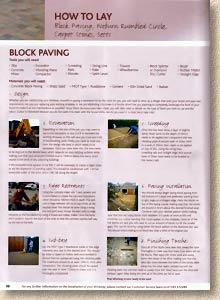
In summary, this is probably the most balanced Bradstone collection for many a year. The move towards creating a definite brand image is working, and there's an impressive range of products to suit every taste and pocket. The inclusion of Bradstone-badged decorative aggs consolidates the brand, and the palette of natural stone products is just enough: with the huge range of imports now available, there's a temptation to offer everything, but Bradstone have stuck to what they do best, concrete products, yet included sufficient natural stone lines to keep their customers happy.
You can order your own copy of the Bradstone 2007 catalogue by filling in the form on the Bradstone website or by calling in at your local stockist.


